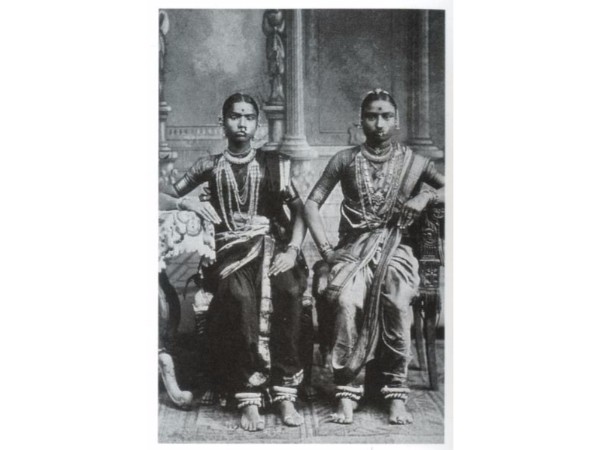India is a home to countless rituals and traditions! When some of these rituals boasts of India's opulent history, some were very obnoxious and tyrannical that they ceased to exist! Devadasi system in Indian temples is one such contentious ritual occurred in Indian temples till it got outlawed in India, in 1988. Let's take a tour to the temples which had practiced this system and see some bizarre facts about Devadasi system prevailed in India.

A photograph of two devadasis in 1920s PC: Shushruth
Devadasi - The servants of God
Devadasi is a system in Hindu temples that came to prevalence in 6th century and became dominant during the medieval period! Devadasi is a girl "dedicated" to worship and service of a deity or a temple for the rest of her life. In addition to taking care of the temple and performing rituals, they excelled in dance and music.
The first reference to dancing girls in temples is found in Kalidasa's "Meghadhoot". Earlier they enjoyed a high stature in the society. After marrying wealthy patrons, they spent their time honing their skills instead of becoming a housewife. During the colonial era, kings in the Indian subcontinent who were the patrons of temples and temple arts became powerless. Thus devadasis were left without their traditional means of support and patronage.

PC: r deangelo
The rise and fall in the status of devadasis can be seen to be running parallel to the rise and fall of Hindu temples. When the Hindu temples were widely invaded, the status of the temples fell quickly. As a result, the devadasis were forced into a life of poverty, misery, and, in many cases, prostitution.
Yellamma Temple in Saundatti
Yellamma Temple in Saundatti is one amongst the most important temples in India which had Devadasi system prevailing. Yellamma temple is a temple dedicated to goddess Yellamma, located on a hillock in Saundatti. Built in 1514, the archaeological evidences found around this temple refer to a temple that existed in between 8th century and 11th century.

PC: Manjunath Doddamani Gajendragad
Built in the Chalukyan and Rashtrakuta style of architecture, Yellamma temple is set in a picturesque backdrop overlooking the Malaprabha river. The goddess worshipped in the temple is associated with Parashurama's mother Renuka, one of the seven divine mothers who protected the earth and its rulers. She is a popularly revered deity in the states of Maharashtra and Karnataka.
Yellamma Devi Fair, held twice a year between April- October, attracts flocks of devotees to her abode! The intriguing fact is that, though banned, thousands still flog to the Yellama temple to offer themselves to the age-old Devadasi system!

PC : Manjunath Doddamani Gajendragad
Smearing red and yellow 'Kumkum' on their foreheads and wearing glass bangles and garlands, young girls embark their journey by tying beads from the goddess' necklace around the neck. The girls must then express their commitment to the deity by parading in total nudity or covering their bodies with leaves of neem. After government orders, the rituals now take place behind closed doors, only attended by temple authorities and family of those who are dedicated to the temple.
There are many more temples which had Devadasi system as a ritual. Such temples are mainly found in the states of Odisha, Karnataka and Maharashtra. Travel to these temples to get to know more about this controversial ritual! Happy Travelling :)



 Click it and Unblock the Notifications
Click it and Unblock the Notifications























